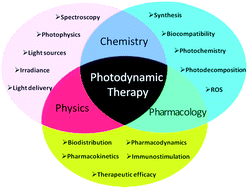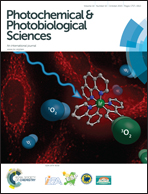Photodynamic therapy (PDT) of cancer: from local to systemic treatment†
Abstract
Photodynamic therapy (PDT) requires a medical device, a photosensitizing drug and adequate use of both to trigger biological mechanisms that can rapidly destroy the primary tumour and provide long-lasting protection against metastasis. We present a multidisciplinary view of the issues raised by the development of PDT. We show how spectroscopy, photophysics, photochemistry and pharmacokinetics of photosensitizers determine the mechanism of cell death and clinical protocols. Various examples of combinations with chemotherapies and immunotherapies illustrate the opportunities to potentiate the outcome of PDT. Particular emphasis is given to the mechanisms that can be exploited to establish PDT as a systemic treatment of solid tumours and metastatic disease.


 Please wait while we load your content...
Please wait while we load your content...